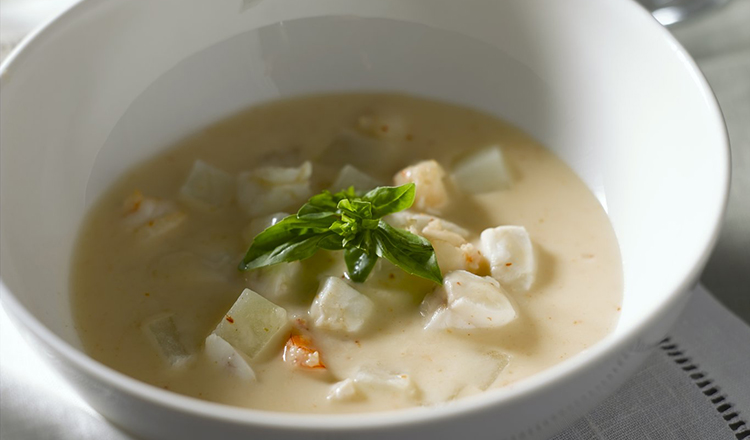Good chowders have a rich flavor, balancing the main flavoring ingredient(s) and supporting aromatic and finishing flavors, a velvety texture, and a lightly thickened consistency, similar to heavy cream. If you are making a shellfish-based chowder (clams, mussels, oysters, etc.), before beginning, steam the main ingredient in stock or water until the shellfish open. Strain the broth through a filter or cheesecloth and reserve. Pick the meat, chop, and reserve.
Prepare the Roux
Many chowders start with cured meats, which is cooked to render, or release, the fat. Render the salt pork or bacon, if using, and add the flour to prepare a roux, which will thicken the soup. It may be necessary to add additional oil or butter to the rendered fat, depending on how you intend to introduce the roux into the soup. If the roux is to be made as part of the overall process, known as the singer method, additional fat is needed.
Add the Aromatic Ingredients
White mirepoix is a common aromatic combination for light-colored chowders, though for other chowders a combination of vegetables, such as carrots, onions, celery, leeks, garlic, and peppers, is also used. Cook the aromatics gently in the rendered fat and/or oil over low heat, until the vegetables are tender and translucent and they begin to release their juices.
Thicken the Soup
Stir the flour into the fat and cook the roux just long enough for it to take on a pale golden color. Slowly whisk in the reserved broth and/or stock. Bring the soup just up to a simmer, stirring frequently. Check the soup’s seasoning and make any necessary adjustments.
Certain ingredients are added to the soup at intervals, depending upon how dense they are and the effect extended cooking might have on them. Tender new peas will become gray and pasty if allowed to cook for too long, but potatoes need time to cook. A spice sachet left in the soup too long may lose its fresh flavor. Consult individual recipes for specific instructions on when to add ingredients.
Finish the Soup
Simmer until all the ingredients are fully cooked and tender and the soup has good flavor. Stir, skim, and adjust seasoning throughout cooking time. Chowders usually need 1 hour of simmering time to develop flavor and thicken properly. Make any necessary adjustments to the consistency now.
The soup is ready to finish now, or it may be rapidly cooled and refrigerated for later service. Return the soup to a simmer over medium heat and add enough hot cream, if using, to enrich the soup, without overwhelming the main ingredient’s flavor. Add the garnish or reserved main ingredient back to the chowder. Return the soup to a simmer and adjust seasoning if necessary. Serve at once in heated bowls or cups.
Tips for Plant-Forward Chowders:
- While chowders are commonly made with milk or cream, you can use plant-based ingredients to achieve this creamy texture and rich flavor. Cashew and oat milk are the creamiest milk alternatives with the most neutral flavor, but you can also blend in puréed ingredients to add body, like soaked nuts, cooked white beans, or steamed cauliflower.
- If you choose not to use bacon or other meat products, you can omit that step without worry. Use a vegetable oil or butter in place of the rendered fat to make the roux, and be sure to taste for seasoning to make up for any missing salt.
- Vegetable broth is a great base for a chowder, but you can also make a broth from the main ingredient of your soup, like corn cobs or mushroom stems. If using a prepared veggie broth, you can fortify it before using with any of these ingredients, too, for an extra boost of flavor.
- If your plant-forward chowder seems bland, it is probably under seasoned or missing an acidic ingredient. Add a squeeze of lemon juice at the end, and make sure to taste for salt and pepper. If that still doesn’t do the trick, looks to fresh herbs—and there’s always a place for hot sauce!


